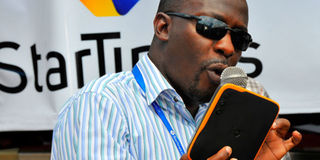Digital migration: What you should know

StarTimes marketing director, Mr Adrine Nsubuga displays one of the new decoders that they have come up with ahead of the digital switch. Competition will be hinged on innovativeness and strategic planning. Photo by Abubakar Lubowa.
What you need to know:
As we approach the digital switch, the broadcasting spectrum is expected to experience a number of changes. But how prepared is the industry?
On June 30, Uganda Communications Commissions (UCC), if it does not default on its promise, will switch off analogue and migrate to digital broadcasting. The switch will complete the more than 10 year plan that seeks to open Uganda and the rest of the world to a large digital spectrum.
Recently, UCC said it would not relax the June 30 deadline even as there are due considerations to push the global switch by at least four months.
But what lies ahead?
According to Charles Hamya, the Multichoice Uganda general manager, the digital switch will generally be an evolution that will free up the broadcasting spectrum to enable mobile phone operators deliver improved and high speed internet.
This, he says will have a knock-on-effect on the economy, given that much of the world now depends on ICT to deliver real growth and development. The migration, Hamya says will also afford Ugandan Tv viewers to have a wider channel reach as well as give low income earners an opportunity to enjoy the benefits of digital broadcasting.
Much of Uganda currently has a poor Tv reception with a number of people in the country side and low lying areas unable to access quality Tv. Uganda, according to UCC has about five million Tv sets with a viewership of about 10 million people.
However, according to Aldrine Nsubuga, the StarTimes marketing director, the migration will raise viewer numbers as more people will get access to quality Tv signal.
This, he says will provide pay Tv and free-to-air service providers an opportunity to increase viewer numbers, a feat that is likely to ignite competition.
The competition, Nsubuga says will spark a price war with service providers seeking for avenues through which they can mark their territory as well as recruiting new subscribers.
How service providers are preparing for the competition?
The market is already getting excited as service providers try to work on measures that will keep them ahead. For instance, Nsubuga says: “We are reading into the future by providing competitive products that are not only relevant but affordable.”
Notably, according to Nsubuga, the switch will create another competitor in form of free-to-air service providers. However, unlike pay Tv decoders, free-to- air set-top-boxes don’t carry subscription charges apart from the purchase price. But these are only limited broadcast local channels.
Which, as Nsubuga says, is an advantage because their platforms [digital] provide a wide channel spectrum and thus “… few viewers will choose free-to-air services because they are costly at first purchase and are limited to local channels.”
Additionally he says: “We want to bring affordability to viewers but with a lot of quality. Recently, StarTimes launched a digital decoder of Shs8,000 and a startup bouquet of Shs6,000 per month.
However, Multichoice, according to Hamya is not sitting back and is likely to provide competition through its Gotv platform. Multichoice also relays DStv. But the challenge would be how these low priced services deliver on quality and consumer satisfaction.
Free-to-air decoders, according to Abdul Mbabazi, the Green Power Solutions marketing manager, are currently available on the market and are vending for between Shs120,000 and Shs300,000.
However, Mbabazi says, they are yet to receive expected customers, probably because analogue channels are still broadcasting. Estimates show that out of the more than five million Tv sets in Uganda, more than 90 per cent are still on analogue.
Innovation is key
The competition, according to Nsubuga (pictured) will be premised on how far service providers are willing to invest in advancing innovation. Recently, StarTimes and Multichoice introduced new decoders that the two companies say are more efficient and appealing to customers. For instance Multichoice recently recalled some of its old decoders and replaced them with others that have enhanced features.
Perspective >
About a fortnight ago, four Kenyan television channels switched off their signal faulting government for failing to allow them more time to prepare for the migration from analogue to digital broadcasting.
The switch off came after sticky court proceedings that gave government a go ahead to implement the migration as planned.
Broadcasters had sued government, saying the migration deadline, which had been put to end of February should be delayed to give them ample time to prepare for the migration. However, the four broadcasters including NTV, Citizen Tv, QTV and KTV on Friday went back on air pending a number of modalities that will be discussed with government.
In Uganda government through Uganda Communications Commission, the broadcasting regulator, recently announced it would not extend the June 30 deadline even as some broadcasters doubt the preparedness on the side of government to implement the migration.
However, Charles Hamya , the Multichoice Uganda general manager told this newspaper in an email, they would support government to implement the migration on time given that enough infrastructure has been put in place to support digital broadcasting.
“...we fully support them,” Hamya told this newspaper in an email exchange.




